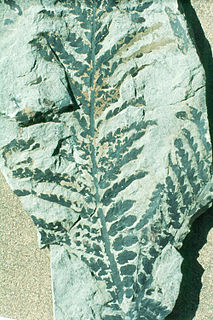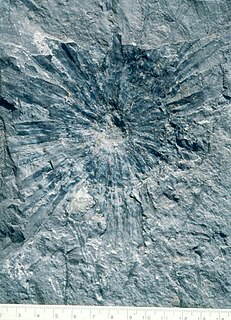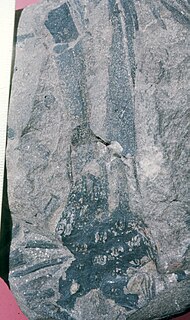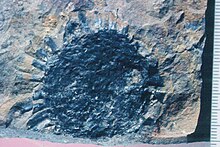The Permian is a geologic period and stratigraphic system which spans 47 million years from the end of the Carboniferous Period 298.9 million years ago (Mya), to the beginning of the Triassic Period 251.9 Mya. It is the last period of the Paleozoic Era; the following Triassic Period belongs to the Mesozoic Era. The concept of the Permian was introduced in 1841 by geologist Sir Roderick Murchison, who named it after the region of Perm in Russia.

The Permian–Triassicextinction event, also known as the End-Permian Extinction and colloquially as the Great Dying, formed the boundary between the Permian and Triassic geologic periods, as well as between the Paleozoic and Mesozoic eras, approximately 251.9 million years ago. It is the Earth's most severe known extinction event, with the extinction of 57% of biological families, 83% of genera, 81% of marine species and 70% of terrestrial vertebrate species. It was the largest known mass extinction of insects.
The Triassic is a geologic period and system which spans 50.6 million years from the end of the Permian Period 251.902 million years ago (Mya), to the beginning of the Jurassic Period 201.36 Mya. The Triassic is the first and shortest period of the Mesozoic Era. Both the start and end of the period are marked by major extinction events. The Triassic Period is subdivided into three epochs: Early Triassic, Middle Triassic and Late Triassic.

Lycopodiopsida is a class of vascular plants known as lycopods, lycophytes or other terms including the component lyco-. Members of the class are also called clubmosses, firmosses, spikemosses and quillworts. They have dichotomously branching stems bearing simple leaves called microphylls and reproduce by means of spores borne in sporangia on the sides of the stems at the bases of the leaves. Although living species are small, during the Carboniferous, extinct tree-like forms formed huge forests that dominated the landscape and contributed to coal deposits.

Isoetes, commonly known as the quillworts, is the only extant genus of plants in the family Isoetaceae, which is in the class of lycopods. There are currently 192 recognized species, with a cosmopolitan distribution but with the individual species often scarce to rare. Some botanists split the genus, separating two South American species into the genus Stylites, although molecular data place these species among other species of Isoetes, so that Stylites does not warrant taxonomic recognition. Species of Isoetes virtually identical to modern forms have existed since the Jurassic epoch.

Isoetales, sometimes also written Isoëtales, is an order of plants in the class Lycopodiopsida.

The Early Triassic is the first of three epochs of the Triassic Period of the geologic timescale. It spans the time between 251.902 Ma and 247.2 Ma. Rocks from this epoch are collectively known as the Lower Triassic Series, which is a unit in chronostratigraphy.

In the geologic timescale, the Middle Triassic is the second of three epochs of the Triassic period or the middle of three series in which the Triassic system is divided in chronostratigraphy. The Middle Triassic spans the time between 247.2 Ma and 237 Ma. It is preceded by the Early Triassic Epoch and followed by the Late Triassic Epoch. The Middle Triassic is divided into the Anisian and Ladinian ages or stages.
Pleuromeia is an extinct genus of lycophytes. They are related to modern quillworts (Isoetes). Pleuromeia dominated vegetation during the Early Triassic all over Eurasia and elsewhere, in the aftermath of the collapse of floral communities during the Permian–Triassic extinction event, often occurring in monospecific assemblages. Its sedimentary context in monospecific assemblages on immature paleosols, is evidence that it was an opportunistic pioneer plant that grew on mineral soils with little competition. It spread to high latitudes with greenhouse climatic conditions. Conifers reoccurred in the Early Anisian, followed by the cycads and pteridosperms during the Late Anisian.

Dicroidium is an extinct genus of fork-leaved seed ferns that were widely distributed over Gondwana during the Triassic. Their fossils are known from South Africa, the Arabian Peninsula, Australia, New Zealand, South America, Madagascar, the Indian subcontinent and Antarctica. They were first discovered in Triassic sediments of Tasmania by Morris in 1845. Fossils from the Umm Irna Formation in Jordan and in Pakistan indicate that these plants already existed in Late Permian. Late surviving members of the genus are known from the Early Jurassic (Sinemurian) of East Antarctica. Within paleobotany, Dicroidium is a form genus used to refers to the leaves, associated with ovuluate organs classified as Umkomasia and pollen organs classified as Pteruchus, while Dicroidum is also used collectively to refer to the whole plant.
Olson's Extinction was a mass extinction that occurred 273 million years ago in the late Cisuralian or early Guadalupian of the Permian period and which predated the Permian–Triassic extinction event. It is named after Everett C. Olson. There was a sudden change between the early Permian and middle/late Permian faunas. Some authors also place a hiatus in the continental fossil record around that time, but others disagree. Since then this event has been realized across many groups, including plants, marine invertebrates, and tetrapods.

Paleontology in Oregon refers to paleontological research occurring within or conducted by people from the U.S. state of Oregon. Oregon's geologic record extends back approximately 400 million years ago to the Devonian period, before which time the state's landmass was likely submerged under water. Sediment records show that Oregon remained mostly submerged until the Paleocene period. The state's earliest fossil record includes plants, corals, and conodonts. Oregon was covered by seaways and volcanic islands during the Mesozoic era. Fossils from this period include marine plants, invertebrates, ichthyosaurs, pterosaurs, and traces such as invertebrate burrows. During the Cenozoic, Oregon's climate gradually cooled and eventually yielded the environments now found in the state. The era's fossils include marine and terrestrial plants, invertebrates, fish, amphibians, turtles, birds, mammals, and traces such as eggs and animal tracks.

Gregory John Retallack is an Australian paleontologist, geologist, and author who specializes in the study of fossil soils (paleopedology). His research has examined the fossil record of soils though major events in Earth history, extending back some 4.6 billion years. Among his publications he has written two standard paleopedology textbooks, said N. Jones in Nature Geoscience "Retallack has literally written the book on ancient soils."

Lepidopteris is a form genus for leaves of Late Permian to Late Triassic Period Pteridospermatophyta, or seed ferns, which lived from around 260 to 200 million years ago in what is now Australia, Antarctica, India, South America, South Africa, Russia and China. Nine species are currently recognized. Lepidopteris was a common and widespread seed fern, which survived the Permian-Triassic extinction event but succumbed to the Triassic-Jurassic extinction event. Lepidopteris callipteroides is especially common between the first two episodes of Permian-Triassic extinction event, and L. ottonis forms a comparable acme zone immediate before the Triassic-Jurassic extinction event. Lepidopteris would persist into the Early Jurassic in Patagonia, represented by the species Lepidopteris scassoi.

Lepidopteris callipteroides is a form species for leaves of Late Permian Pteridospermatophyta, or seed ferns, which lived from around 252 million years ago in what is now Australia, and Madagascar. Lepidopteris callipteroides was an immediate survivor of the largest Permian-Triassic extinction event, migrating southward with the post-apocalyptic greenhouse spike.

Isoetes beestonii is the oldest known species of the living quillwort genus from the latest Permian of New South Wales and Queensland. Originally considered earliest Triassic, it is now known to be latest Permian in age, immediately before the Permian Triassic mass extinction.
Pleuromeiaceae is an extinct family of plants related to living quillworts (Isoetes), but with tall stems and terminal compact cones. They were especially widespread globally in the aftermath of the Permian Triassic mass extinctions.

Pleuromeia dubia is a tall species for the genus, with distinctive elongate leaf scars, and known from the Early Triassic of Australia and South Africa. Like other species of Pleuromeia it was a survivor of the marked greenhouse spike at the end of the Early Triassic.

Cylostrobus is genus of Lycopsida most like Pleuromeia, but with very compact and round cones. It is known from the Early Triassic of Australia, coincident with a marked greenhouse spike at the end of the Early Triassic. The genus Cylostrobus was erected for the compact cone only, in the paleobotanical system of form genera, but these small plants are well enough understood that the name Cylostrobus sydneyensis is used for the whole plant, rather than the old name Pleuromeia longicaulis. Other species of Pleuromeia have attached cones that are less compact and produce different spores.

















